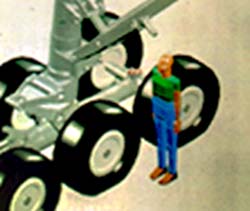



[ Design Philosophies | Design-Build Team | CATIA | Testing and ETOPS ]
Computer - Aided Design/ New Design Techniques
What is CATIA?
 The Boeing 777 is the first jetliner to be 100 percent digitally designed
using three-dimensional solids technology. Throughout the design process, the airplane
was "preassembled" on the computer, eliminating the need for a costly,
full-scale mock-up. The 777 Division is using CATIA (computer-aided, three-dimensional
interactive application) and ELFINI (Finite Element Analysis System), both developed
by Dassault Systemes of France and licensed in the United States through IBM. Designers
also use EPIC (Electronic Preassembly Integration on CATIA) and other digital preassembly
applications developed by Boeing. IBM and Boeing enhanced the software and added
a human touch by creating Catia man, a computer-simulated mechanic who can climb
inside the digital airplane to show how difficult it is for a real person to reach
problem areas and make repairs. One of its early discoveries was that a human mechanic
could not reach a navigation light on the roof of the plane to change the light bulb.
Without the digital mechanic, Boeing might not have found out about the bulb problem
until it caused a flight delay at an airport.
The Boeing 777 is the first jetliner to be 100 percent digitally designed
using three-dimensional solids technology. Throughout the design process, the airplane
was "preassembled" on the computer, eliminating the need for a costly,
full-scale mock-up. The 777 Division is using CATIA (computer-aided, three-dimensional
interactive application) and ELFINI (Finite Element Analysis System), both developed
by Dassault Systemes of France and licensed in the United States through IBM. Designers
also use EPIC (Electronic Preassembly Integration on CATIA) and other digital preassembly
applications developed by Boeing. IBM and Boeing enhanced the software and added
a human touch by creating Catia man, a computer-simulated mechanic who can climb
inside the digital airplane to show how difficult it is for a real person to reach
problem areas and make repairs. One of its early discoveries was that a human mechanic
could not reach a navigation light on the roof of the plane to change the light bulb.
Without the digital mechanic, Boeing might not have found out about the bulb problem
until it caused a flight delay at an airport.
Workstations/Mainframes
Instead of producing drawings on reams of paper, designers store their work inside the memory of eight IBM mainframes. In the Puget Sound area, approximately 1,700 individual computer workstations are linked to the largest mainframe installation of its kind in the world, consisting of four IBM mainframe computers. This mainframe cluster also is linked to mainframes and workstation installations in Japan; Wichita, Kan.; Philadelphia; and other locations.
Digital Preassembly
 Gone
are the days of drafting tables and full - sized, costly metal mockups. Instead,
engineers put parts together in a computer simulation to test them before the manufacturing
begins. Using the three-dimensional solid images generated on the computer, the 777
airplane can be preassembled to position parts correctly, ensuring a proper fit.
Like a "spell - check" device for airplanes, the computer tells engineers
if parts don't fit. Designers can then move the parts around or adjust them through
computer modeling. Boeing is hoping that through computer design and assembly it
will have 50 % less rework on problems discovered at the factory after the planes
are delivered. Workers are finding that many of the parts fit together more precisely,
eliminating need for additional tooling on the factory floor. "Digital pre -
assembly is the savior of the factory floor," says Bob Cullen, Boeing's 777
general supervisor of aft/body sections. Floor beams, for example, were assembled
in three weeks instead of the anticipated 19 weeks. Boeing has used computer - aided
design on other planes, but the 777 marks the first time it has designed and pre
- assembled a commercial jet solely by computer.
Gone
are the days of drafting tables and full - sized, costly metal mockups. Instead,
engineers put parts together in a computer simulation to test them before the manufacturing
begins. Using the three-dimensional solid images generated on the computer, the 777
airplane can be preassembled to position parts correctly, ensuring a proper fit.
Like a "spell - check" device for airplanes, the computer tells engineers
if parts don't fit. Designers can then move the parts around or adjust them through
computer modeling. Boeing is hoping that through computer design and assembly it
will have 50 % less rework on problems discovered at the factory after the planes
are delivered. Workers are finding that many of the parts fit together more precisely,
eliminating need for additional tooling on the factory floor. "Digital pre -
assembly is the savior of the factory floor," says Bob Cullen, Boeing's 777
general supervisor of aft/body sections. Floor beams, for example, were assembled
in three weeks instead of the anticipated 19 weeks. Boeing has used computer - aided
design on other planes, but the 777 marks the first time it has designed and pre
- assembled a commercial jet solely by computer.
System Benefits
Improved quality of work; reduced changes and errors, and less rework, resulting in lower costs.
![]()
![]()